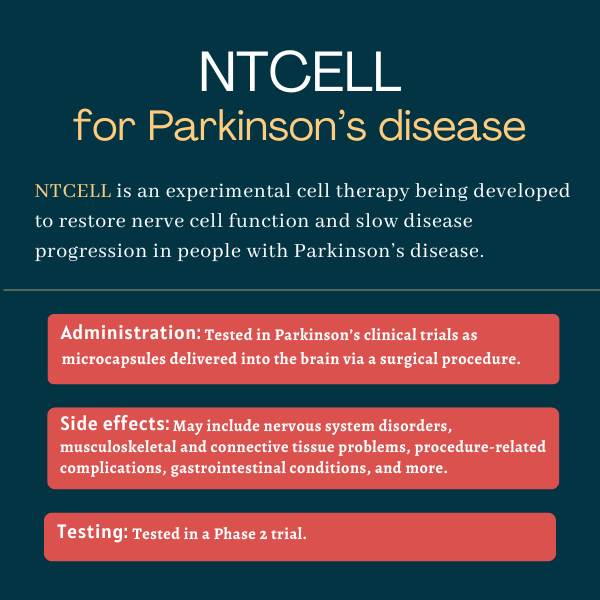NTCELL for Parkinson’s disease
Last updated Jan. 30, 2025, by Andrea Lobo, PhD

What is NTCELL for Parkinson’s disease?
NTCELL is an experimental cell therapy being developed by Algorae Pharmaceuticals (formerly Living Cell Technologies) to promote the growth of new nerve cells and repair nerve cell damage in people with Parkinson’s disease. Delivered via a surgical procedure into the brain, it is designed to restore nerve cell function and slow disease progression.
Therapy snapshot
| Treatment name: | NTCELL |
| Administration: | Administered as microcapsules directly into the brain via surgery |
| Clinical testing: | Tested in Phase 1/2 trials |
How does NTCELL work in Parkinson’s disease?
Parkinson’s disease is caused by the death and dysfunction of dopaminergic neurons, the nerve cells in the brain responsible for making dopamine, in a brain region called the substantia nigra. Dopamine is a chemical messenger essential for motor control. The loss of these nerve cells leads to impaired dopamine signaling in the brain, ultimately resulting in most of the disease’s symptoms.
NTCELL is a cell therapy consisting of capsules containing clusters of piglet’s choroid plexus cells, which are cells in the fluid-filled spaces of the brain. These cells are sourced from a unique herd of disease-free pigs that are bred from animals originally identified in the Auckland Islands in New Zealand.
Choroid plexus cells are brain cells that naturally produce cerebrospinal fluid (CSF), the liquid that surrounds the brain and spinal cord and contains nerve growth factors that support nerve cell function and growth.
The cells are coated with alginate using Algorae’s proprietary technology Immupel that protects them from the immune system, eliminating the need for immunosuppressive medications during treatment.
The capsules are implanted into the brain where they can function as a factory to produce CSF and release growth factors that promote the repair of damaged nerve cells and the growth of new nerve cells. They are also thought to contribute to the cleaning of abnormal protein clumps inside nerve cells, a hallmark of Parkinson’s disease.
Therefore, the treatment is thought to restore nerve cell function and slow disease progression in Parkinson’s patients.
In preclinical studies, the treatment was shown to restore dopaminergic signaling in nerve tissue and restore neurological function in a monkey model of Parkinson’s disease.
How is NTCELL administered?
In a Phase 2 clinical trial, NTCELL was administered as microcapsules, using a dosage range of 80 to 240 microcapsules, directly to the putamen, a region of the striatum involved in motor control. The therapy is delivered through thin tubes, or catheters, inserted via small skull openings under general anesthesia with imaging guidance.
NTCELL in clinical trials
NTCELL’s safety and efficacy was assessed in two clinical trials in people diagnosed with Parkinson’s disease for at least five years.
Phase 1/2a trial
The therapy was first tested in an open-label Phase 1/2a trial (NCT01734733) that enrolled four people, ages 40 to 70 years, at a site in New Zealand.
Patients were implanted with 40 NTCELL capsules on one side of the putamen, which was well tolerated, with no adverse events related to the therapy identified. Treatment efficacy was assessed using neurological rating scales, particularly the Unified Parkinson’s Disease Rating Scale (UPDRS), which is used to evaluate disease severity and progression, and where lower scores are associated with improved outcomes.
After 26 weeks (about six months), treatment was shown to slow disease progression, and after about 2.5 years, it continued to demonstrate an easing of disease symptoms, particularly motor function.
Phase 2b trial
NTCELL’s safety and efficacy were further evaluated in a Phase 2b trial (NCT02683629), which enrolled 18 Parkinson’s patients, ages 56 to 65 years, with moderately advanced disease at a site in New Zealand. Patients were divided into three groups of six patients and within each group, they were randomly assigned to receive NTCELL or a sham surgery (where patients were subjected to the same procedure but without the therapy being delivered).
Three doses of 80, 160, or 240 capsules per patient, delivered on both sides of the brain, were tested. Patients could receive other medications for Parkinson’s, including levodopa and its derivatives.
Overall, after 26 weeks (about six months), there were no significant changes in total UPDRS scores or motor scores, patients’ reported quality of life, and dyskinesia, or involuntary movements, associated with long-term use of dopaminergic medications.
However, when separately analyzing the three dosing groups, treatment with 160 capsules significantly decreased patients’ total and motor UPDRS scores during on time — periods when symptoms are adequately controlled with medication — compared to those who received a placebo.
The treatment was generally safe and well tolerated, with most adverse events being mild to moderate in intensity, and considered unrelated to treatment. Three severe adverse events were reported: two in the placebo group of joint inflammation and injury to intervertebral discs, which separate spinal vertebrae and help support movement, and nausea in one patient receiving the highest treatment dose.
In a long-term follow-up, NTCELL’s efficacy was assessed for up to two years. While there were no significant differences in UPDRS motor scores compared to the placebo in the off state (periods when the effects of medication have worn off), patients who received the 80 or 160 capsules dosing experienced a significant reduction in total UPDRS and motor scores during on periods.
Additionally, no benefits were observed with the maximum dose, which was considered to be beyond the maximum tolerated dose.
Other clinical trials
In 2023, the company began reassessing the NTCELL clinical trial protocol and development plan to explore possible improvements to the therapy’s effectiveness. Following a scientific review, the company planned to start a third clinical trial in collaboration with Nzeno, a New Zealand-based company that breeds and maintains pathogen-free pigs to obtain choroid plexus tissue to produce the cell therapy. However, Algorae terminated this collaboration in early 2024.

Common side effects of NTCELL
In clinical trials, the most reported side effects were mild to moderate in severity and deemed unrelated to the treatment, and few serious adverse events were reported.
The most frequently reported side effects included:
- nervous system disorders
- musculoskeletal and connective tissue problems
- injury, poisoning, or procedure complications
- gastrointestinal issues
- infections and infestations.
Parkinson’s News Today is strictly a news and information website about the disease. It does not provide medical advice, diagnosis, or treatment. This content is not intended to be a substitute for professional medical advice, diagnosis, or treatment. Always seek the advice of your physician or other qualified health provider with any questions you may have regarding a medical condition. Never disregard professional medical advice or delay in seeking it because of something you have read on this website.
Recent Posts
- Finding ways to make Parkinson’s hospital care more ‘age friendly’
- Don’t wait for a health crisis to practice self-care
- Exercise intensity matters in early Parkinson’s: Mouse study
- Untreated sleep apnea raises Parkinson’s risk, but CPAP helps
- New global alliance unites platform trials to hasten Parkinson’s research
Related content






